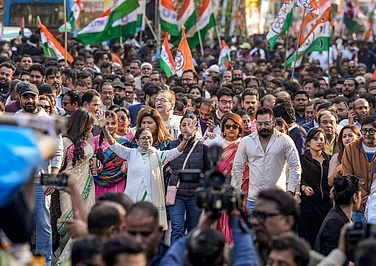The word Nihang conjures up the image of a Sikh armed with traditional weapons and dressed in a loose blue top almost touching his knees, long (generally white) breeches, and a turban of more than usual length. Among all the diverse communities and distinct sects within the broad religious tradition of Sikhism, the Nihangs stand out. The prevalence of numerous traditions and practices in the Indian religious landscape makes it possible for Nihangs to pass for just another group with a distinct identity. Not every tradition within the Sikh religion culminates in the formation of a distinct community, but the possibility exists. Moreover, when a religious tradition emerges, there is always a likelihood that it borrows from other existing traditions. It is in this context that the existence of Nihangs should be understood.
Enigmatic objects of curiosity for most people because of their exotic looks, and often seen as orthodox Sikhs with medieval weaponry, they are treated as outsiders in the everyday life of the larger Sikh community. This is so despite the visibility of Nihangs being acknowledged as normal on certain auspicious occasions at particular historic gurdwaras associated with specific events in the lives of the Sikh gurus.
The present form and content of the Sikh religion owes its existence to the Singh Sabha movement, which subsequently culminated in the enactment of the Gurdwara Act of 1925. The Shiromani Gudwara Parbandhak Committee (SGPC) that was constituted following this enactment has been consistently making an attempt to create a monolithic community of the Khalsa faith. By Khalsa, the Sikhs generally mean “the pure”, but it actually means—and that too metaphorically—“people of God”. As part of the bhakti tradition, the first guru and founder of Sikhism, Guru Nanak Dev, preached equality of worship, physical labour to earn a living, sharing and praying to the almighty as the major principles of righteous living. He rejected celibacy, while endorsing asceticism in personal conduct. According to Sikh tradition, Guru Nanak emphasised that a person could achieve ultimate bliss even by raising a family.
Besides preaching the ideas of the founder, the nine gurus who followed him as successors consecutively added to and enriched the Sikh tradition. The ninth and tenth gurus—Guru Tegh Bahadur and Guru Gobind Singh—are given the major share of credit for establishing Sikhism as a distinct religion, though it would have been impossible for them to accomplish this without the compilation of the Adi Granth by the fifth guru. The emergence of diversity within the Sikh religion has been an empirical reality despite the hegemonic influence of the tenth guru on the Sikh psyche. In fact, most legends and narratives that give an insight into how the Nihangs might have come into existence trace their origin by linking them to the tenth guru.
The public’s knowledge about Nihangs is made up mostly of hearsay. Some call them a samparada (community), but one must remember that they are largely males and symbolise the image of male warriors carrying weapons; some of the groups are on the move throughout the year (the reason why they call their dera shauni, or cantonment); and most of them remain unmarried, except the Nihangs who maintain gurdwaras/deras when the rest are on the move. In contrast to Sikhs who exclusively regard the Guru Granth Sahib as the 11th guru and confine their recitations to it, the Nihangs have two other sacred texts—Dasam Granth and Sarab Loh Granth. The Nihang gurdwara is distinct from the other gurdwaras because they keep the Dasam Granth in addition to the Guru Granth Sahib.
There is also a distinct space in the Nihang gurdwara for the preparation of sukha, a beverage made of cannabis and also known by many other names. The sacred world of Nihangs is inseparable from the composite and ancient Hindu religious tradition, with consumption of cannabis being a notable aspect of daily life that connects them to sadhus. This distinguishes them from the monolithic tradition established by the Tat Khalsa in the beginning of the 20th century and continued by the SGPC. Unlike the sadhus, however, Nihangs do not smoke cannabis.

Nihangs gather in Amritsar to mark the day Guru Hargovind returned from prison.
Regarding themselves as “guru ki fauj” (army of the guru), Nihangs tend to be always ready to proceed to the war front. Shauni is the place where they keep horses and look after them. Certain Nihang groups claim to be “chalda vaheer” (mobile band). Of the 14 major groups of Nihangs identified by scholars, 11 are Taruna Dals and three are Buddha Dals, one of which has its headquarters at Mata Sahib Devan gurdwara in Nanded, Maharashtra.
Contrary to the general impression based on what their names indicate—that Buddha Dal is a group of elder Nihangs, whereas Taruna Dal has something to do with youth—both groups, in fact, comprise young as well as elder Nihangs in their ranks. Each dal is headed by a jathedar and under him are a large number of gurdwaras. It is claimed that the headquarters of Buddha Dal is located at Talwandi Ber Sahib gurdwara, whereas Baba Bakala is the location of Taruna Dal’s headquarters.
Ranghreta Dal and Bidhi Chand Taruna Dal are less prominent than Buddha Dal and Taruna Dal. Not much is talked about Ranghreta Dal, which comprises Nihangs exclusively belonging to the Mazabi caste, while those who identify with Bidhi Chand, a devout follower of the sixth guru of Sikhs, are confined to his village—Sur Singh village in Tarn Taran district.
The Nihang dals strictly observe daily rituals irrespective of whether they are stationed at deras or moving towards other destinations according to their annual calendar. Their daily routine corresponds to the general Sikh principles applicable to the Khalsa Sikhs, except certain distinctive practices confined to them. Nihangs strictly adhere to the annual calendar in their movements. There is a definite pattern as they travel to sites connected with the life events of the Sikh gurus, marking their anniversaries. Gurdwaras have been constructed at these locations. One way to map their movement is to describe the dates and destinations.
On the day of Maghi (the first day of the Magh month in the Bikrami calendar, which is January 14 or 15), the Nihang dals reach Muktsar Sahib, where Guru Gobind Singh blessed 40 Sikhs with immortality—the “chali mukte” (40 immortals). The tenth guru is also said to have been fond of playing Holi and the Nihangs reach Anandpur Sahib for the occasion (Holla Mohalla). The third destination, on Vaisakhi, April 13, is Damdama Sahib (Talwandi Sabo), where Guru Gobind Singh took rest after leaving Anandpur Sahib, and is said to have dictated the entire Guru Granth Sahib to Bhai Mani Singh and Baba Deep Singh.

Anniversary of Guru Granth Sahib’s installation.
The fourth destination is Baba Bakala, where Guru Tegh Bahadur was recognised as the ninth guru of the Sikhs on the day of Raksha Bandhan, sometime in July or August. During the festival of Dussehra, the Nihang dals go to Nanded and gather at Chamkaur Sahib, where two of Guru Gobind Singh’s sons were martyred, and at Hazoor Sahib, where the tenth guru spent his final years. Then the Nihangs celebrate Diwali at Golden Temple in Amritsar, as it was during the festival of lights that Guru Hargobind, the sixth guru of the Sikhs, reached Amritsar after his release from Gwalior prison. The last destination is Fatehgarh Sahib at the Jorh Mela in the last week of December. It is the place where another two sons of Guru Gobind Singh were martyred.
However, except for their reverence for Guru Nanak, Nihangs do not organically link with the tradition established by him. While they present a departure from the composite tradition of Sufis and Jogis, many features of their way of life are similar to that of the Hindu warrior ascetics—the Nagas. Not only do both use the same kind of weapons, Nihangs also use the word akhara to describe the place where they are trained to wield them. This is similar to the word’s use in Hindu tradition to denote a wrestling ground.
(The writer is professor of sociology at Guru Nanak Dev University, Amritsar)






















